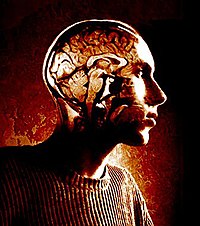Introduction to Psychology 1/IPSY103/Evolutionary psychology/Introduction to evolution
However, we all know that our ancestors hundreds of thousands of years ago weren’t driving sports cars or wearing designer clothes to attract mates. So how could someone ever say that such behaviors are “biologically programmed” into us? Well, even though our ancestors might not have been doing these specific actions, these behaviors are the result of the same driving force: the powerful influence of evolution. Yes, evolution—certain traits and behaviors developing over time because they are advantageous to our survival. In the case of dating, doing something like offering a gift might represent more than a nice gesture. Just as chimpanzees will give food to mates to show they can provide for them, when you offer gifts to your dates, you are communicating that you have the money or “resources” to help take care of them. And even though the person receiving the gift may not realize it, the same evolutionary forces are influencing his or her behavior as well. The receiver of the gift evaluates not only the gift but also the gift-giver's clothes, physical appearance, and many other qualities, to determine whether the individual is a suitable mate. But because these evolutionary processes are hardwired into us, it is easy to overlook their influence.
To broaden your understanding of evolutionary processes, this module will present some of the most important elements of evolution as they impact psychology. Evolutionary theory helps us piece together the story of how we humans have prospered. It also helps to explain why we behave as we do on a daily basis in our modern world: why we bring gifts on dates, why we get jealous, why we crave our favorite foods, why we protect our children, and so on. Evolution may seem like a historical concept that applies only to our ancient ancestors but, in truth, it is still very much a part of our modern daily lives.
Basics of evolutionary theory
Evolution simply means change over time. Many think of evolution as the development of traits and behaviors that allow us to survive this “dog-eat-dog” world, like strong leg muscles to run fast, or fists to punch and defend ourselves. However, physical survival is only important if it eventually contributes to successful reproduction. That is, even if you live to be a 100-year-old, if you fail to mate and produce children, your genes will die with your body. Thus, reproductive success, not survival success, is the engine of evolution by natural selection. Every mating success by one person means the loss of a mating opportunity for another. Yet every living human being is an evolutionary success story. Each of us is descended from a long and unbroken line of ancestors who triumphed over others in the struggle to survive (at least long enough to mate) and reproduce. However, in order for our genes to endure over time—to survive harsh climates, to defeat predators—we have inherited adaptive, psychological processes designed to ensure success.
At the broadest level, we can think of organisms, including humans, as having two large classes of adaptations—or traits and behaviors that evolved over time to increase our reproductive success. The first class of adaptations are called survival adaptations: mechanisms that helped our ancestors handle the “hostile forces of nature.” For example, in order to survive very hot temperatures, we developed sweat glands to cool ourselves. In order to survive very cold temperatures, we developed shivering mechanisms (the speedy contraction and expansion of muscles to produce warmth). Other examples of survival adaptations include developing a craving for fats and sugars, encouraging us to seek out particular foods rich in fats and sugars that keep us going longer during food shortages. Some threats, such as snakes, spiders, darkness, heights, and strangers, often produce fear in us, which encourages us to avoid them and thereby stay safe. These are also examples of survival adaptations. However, all of these adaptations are for physical survival, whereas the second class of adaptations are for reproduction, and help us compete for mates. These adaptations are described in an evolutionary theory proposed by Charles Darwin, called sexual selection theory.


